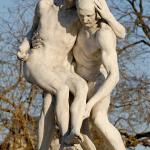To what extent can clear thinking and logical analysis help untangle the complexities of trying to live a life of faith? Let’s try a test case. In his later years, as he continued to discard the grave-clothes from his religious past, my father![17251_297220732720_3663220_n[1]](https://wp-media.patheos.com/blogs/sites/766/2013/06/17251_297220732720_3663220_n1.jpg?w=300) was fond of saying that “Not every mystic is a Christian, but every good Christian is a mystic.” The philosopher in me immediately wants to analyze this truth claim logically. Actually, there are two truth claims in this sentence. The first claim, “Not all mystics are Christians,” relates the category “mystic” and the category “Christian.” If we imagine circle A containing all mystics, and circle B containing all Christians, how should these circles be drawn in relation to each other? For those of you who took Logic 101 in college or maybe in a really good high school, you might remember that these are called “Venn diagrams.” So let’s have logic class for a few minutes.
was fond of saying that “Not every mystic is a Christian, but every good Christian is a mystic.” The philosopher in me immediately wants to analyze this truth claim logically. Actually, there are two truth claims in this sentence. The first claim, “Not all mystics are Christians,” relates the category “mystic” and the category “Christian.” If we imagine circle A containing all mystics, and circle B containing all Christians, how should these circles be drawn in relation to each other? For those of you who took Logic 101 in college or maybe in a really good high school, you might remember that these are called “Venn diagrams.” So let’s have logic class for a few minutes.
There are four possible ways in which circles A and B can be drawn in relation to each other:
1. Circle A is entirely contained within circle B (“All A’s are B’s, not all B’s are A’s”)
2. Circle B is entirely contained within circle A (“All B’s are A’s, not all A’s are B’s”)
3. Circles A and B have no relation to each other. (“No A’s are B’s, no B’s are A’s”)
4. Circles A and B intersect. (“Some A’s are B’s, some B’s are A’s”)
Remember my father’s first claim: “Not every mystic (A) is a Christian (B).” Looking at the diagrams above, we can immediately rule out possibility 1, since it claims that all A’s are B’s, while Dad’s claim says they aren’t. Unfortunately, options 2-4 are all compatible with Dad’s claim that “Not every mystic is a Christian”—do not continue until you can see for yourself why this is the case! So which of the remaining three possible relationships of circles A and B is the right one?
![images[8]](https://wp-media.patheos.com/blogs/sites/766/2013/06/images81.jpg) Fortunately, my father helps us out with his second claim, “All good Christians are mystics.” But wait a minute. What’s the deal with this “good” thing? Where did that come from? I thought we were only talking about mystics and Christians! What we have here is a classic case of a “suppressed premise”—not surprising, since we all suppress premises all the time, especially premises we want to slip unnoticed under the radar screen. A suppressed premise in a discussion is something important to your argument that you consider to be true, but aren’t bothering to tell the listener or reader about, for any number of reasons. In this case, Dad’s suppressed premise is that “Some Christians are good and some aren’t.” He’s slipped in a qualifier (“good”) into his second claim via a suppressed premise.
Fortunately, my father helps us out with his second claim, “All good Christians are mystics.” But wait a minute. What’s the deal with this “good” thing? Where did that come from? I thought we were only talking about mystics and Christians! What we have here is a classic case of a “suppressed premise”—not surprising, since we all suppress premises all the time, especially premises we want to slip unnoticed under the radar screen. A suppressed premise in a discussion is something important to your argument that you consider to be true, but aren’t bothering to tell the listener or reader about, for any number of reasons. In this case, Dad’s suppressed premise is that “Some Christians are good and some aren’t.” He’s slipped in a qualifier (“good”) into his second claim via a suppressed premise.
Once we realize this, we can choose between options 2-4 above. Option 2 doesn’t work, because that places the entire Christian circle (B) within the mystic circle (A), and doesn’t provide any guidance for making the further distinction between good and non-good Christians. Same problem with option 3—if circles A and B have no relation to each other, then we once again have no way to distinguish between good and non-good Christians. That leaves us with option 4, and indeed it provides the help we need. Look again at the intersecting circles in diagram 4. If we shade in the area where A and B intersect, we have a diagram representing the truth of both of Dad’s claims. “Not every mystic is a Christian” is right in front of us, because there is an area of circle A that does not intersect with B—in this non-intersecting area are those mystics who are not Christians.![QED_BW_logo[1]](https://wp-media.patheos.com/blogs/sites/766/2013/06/qed_bw_logo1.jpg?w=300) “All good Christians are mystics” is also in front of us, if we write “good Christians” in the shaded area where A and B intersect. That shaded area contains the Christians who are also mystics (“good” Christians), while the area of circle B not intersecting with A contains all other Christians, who are non-mystics (and apparently non-good).
“All good Christians are mystics” is also in front of us, if we write “good Christians” in the shaded area where A and B intersect. That shaded area contains the Christians who are also mystics (“good” Christians), while the area of circle B not intersecting with A contains all other Christians, who are non-mystics (and apparently non-good).
Wasn’t that fun? Haven’t you learned a lot? At this point, intelligent students should be asking: “But what have we learned about mystics and Christians from this logical analysis”? And the answer is: ABSOLUTELY NOTHING. What we have discovered in this exercise is the logical structure of my father’s claim, but nothing about the content. ![banana doxie[1]](https://wp-media.patheos.com/blogs/sites/766/2013/06/banana-doxie1.jpg?w=300) The logical structure of “Not all dachshunds are bananas, but all good bananas are dachshunds” is the same as the structure of my Dad’s claim. More often than not, logical analyses of truth claims turn out to be what Muriel Barbery calls “a conceptual fuss in the service of nothing.” So what if we know what the logical structure of Dad’s claim about mystics and Christians is—what we really want to know is whether it is true.
The logical structure of “Not all dachshunds are bananas, but all good bananas are dachshunds” is the same as the structure of my Dad’s claim. More often than not, logical analyses of truth claims turn out to be what Muriel Barbery calls “a conceptual fuss in the service of nothing.” So what if we know what the logical structure of Dad’s claim about mystics and Christians is—what we really want to know is whether it is true.
That all depends on what one means by “Christian” and “mystic.” Just how elastic is the category and concept “Christian”? How far can I stretch its meaning before it stops meaning anything at all? As for “mystic,” I have at least a dozen definitions of “mysticism” and related terms in my hard drive, taken over the past few years from authors that I respect and love. None of the definitions is the same; some are radically different from others. ![ee24810ae7a068542122d110.L._V260843872_SX200_[1]](https://wp-media.patheos.com/blogs/sites/766/2013/06/ee24810ae7a068542122d110-l-_v260843872_sx200_1.jpg?w=105) My current favorite definition of “mystic” comes from a talk by Rabbi Lawrence Kushner that I read recently. He prefaces his definition by saying “Don’t get me wrong. I’m not what you’d call a big-time mystic.” Well, neither am I. Kushner goes on to define “mystic” as “someone who has the gnawing suspicion that just beneath the apparent contradictions, brokenness, and discord of this everyday world lies a hidden unity.” If so, I’m a mystic after all (although not a “big-time” one).
My current favorite definition of “mystic” comes from a talk by Rabbi Lawrence Kushner that I read recently. He prefaces his definition by saying “Don’t get me wrong. I’m not what you’d call a big-time mystic.” Well, neither am I. Kushner goes on to define “mystic” as “someone who has the gnawing suspicion that just beneath the apparent contradictions, brokenness, and discord of this everyday world lies a hidden unity.” If so, I’m a mystic after all (although not a “big-time” one).
Twenty-five years ago, I regularly sang in an Episcopal church choir. Since the church was the cathedral of the diocese, the music was slightly better than garden-variety church stuff, but the choir was still pretty much a mixed bag. ![choir.fe[1]](https://wp-media.patheos.com/blogs/sites/766/2013/06/choir-fe1.jpg?w=150) There were five or six sopranos and an equal number of altos, including one close-to-professional quality ringer in each section. We had only two tenors, one a fellow over seventy years old who probably once had a good voice when he was younger and a much younger fellow who sang with gusto but was tone-deaf. The baritones (my section) were more numerous, usually at least four or five. I don’t have a good solo voice, but I am a good choir singer because I read music well and have good pitch. I was the guy all of the other baritones crowded around with a new piece in order to get things right.
There were five or six sopranos and an equal number of altos, including one close-to-professional quality ringer in each section. We had only two tenors, one a fellow over seventy years old who probably once had a good voice when he was younger and a much younger fellow who sang with gusto but was tone-deaf. The baritones (my section) were more numerous, usually at least four or five. I don’t have a good solo voice, but I am a good choir singer because I read music well and have good pitch. I was the guy all of the other baritones crowded around with a new piece in order to get things right.
One Easter season, our primary Easter Sunday piece was going to be Randall Thomson’s Alleluia. The words are easy—all you sing is “Alleluia” all the way through with one “Amen” on the end. The notes are moderately challenging, but this was by no means the most technically difficult piece the choir had ever sung. The piece is sung a capella; for it to work, the singers need the same sort of “oneness” that Gregorian chant requires—they have to become one voice, rather than fifteen or so individual ones. Furthermore, they have to stay in tune for five minutes without accompaniment. ![200606The_Vision_of_Isaiah57x72in_canvas[1]](https://wp-media.patheos.com/blogs/sites/766/2013/06/200606the_vision_of_isaiah57x72in_canvas1.jpg?w=300) And it wasn’t happening. After several mediocre attempts in rehearsal Charles, our organist and choirmaster, yelled “STOP!” After regaining his composure, he said “the Bible says that around the throne of God, the cherubim and seraphim continually sing ‘Alleluia’ in never-ending praise. For the next five minutes let’s plug into that eternal song, joining ‘with angels and archangels and with all the company of heaven,’ just as the Sanctus from mass every Sunday says. Begin.” And for the next five minutes, that’s where we were. We left our individual, fragmented and discordant existences and joined “all the company of heaven who forever sing this hymn to proclaim the glory of your Name.” I get chills as I remember and write about it, more than twenty-five years later. As we ended Alleluia with a hushed “Amen,” our tone-deaf tenor said it all: “Whoa! Where did that come from?”
And it wasn’t happening. After several mediocre attempts in rehearsal Charles, our organist and choirmaster, yelled “STOP!” After regaining his composure, he said “the Bible says that around the throne of God, the cherubim and seraphim continually sing ‘Alleluia’ in never-ending praise. For the next five minutes let’s plug into that eternal song, joining ‘with angels and archangels and with all the company of heaven,’ just as the Sanctus from mass every Sunday says. Begin.” And for the next five minutes, that’s where we were. We left our individual, fragmented and discordant existences and joined “all the company of heaven who forever sing this hymn to proclaim the glory of your Name.” I get chills as I remember and write about it, more than twenty-five years later. As we ended Alleluia with a hushed “Amen,” our tone-deaf tenor said it all: “Whoa! Where did that come from?”
To my ears, there was nothing mystical or magical about our Easter morning performance a few days later. We were in tune, we didn’t embarrass ourselves, but we were not inspired. Afterwards, though, I overheard an old parishioner say to two of my fellow choristers that “you sang like angels today.” Maybe so, I thought. I know that we did at least once—maybe on Easter morning, she was the one who had “ears to hear.” As Rabbi Kushner, I have the gnawing suspicion that this transcendence is there all the time. I’m grateful when, every once in a while, I can say “surely God was in this place” and mean it.![Alleluia-5[1]](https://wp-media.patheos.com/blogs/sites/766/2013/06/alleluia-51.gif?w=225)












